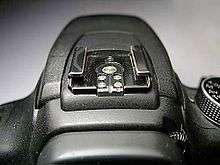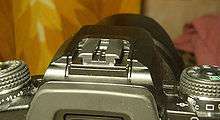Hot shoe


A hot shoe is a mounting point on the top of a camera to attach a flash unit and other compatible accessories. It takes the form of an angled metal bracket surrounding a metal contact point which shorts an electrical connection between camera and accessory for standard, brand-independent flash synchronization.
The hot shoe largely supplanted the "accessory shoe" or "cold shoe", intended to hold flashes that connected electronically via an outboard cable, prevalent in the 1970s. These earlier accessory shoes were mostly the same U shape, and thus provided the template for the introduction of the hot shoe.
The dimensions of the hot shoe are defined by the International Organization for Standardization in ISO 518:2006, but manufacturers differ in details such as trigger voltage and thus incompatibilities are still possible between brands.
Design
The hot shoe is shaped somewhat like an inverted, squared-off "U" of metal. The matching adapter on the bottom of the flash unit slides in from the back of the camera and is sometimes secured by a clamping screw on the flash. In the center of the "U" is a metal contact point. This is used for standard, brand-independent flash synchronization. Normally the metal of the shoe and the metal of the contact are electrically isolated from each other. To fire the flash, these two pieces are shorted together. The flash unit sets up a circuit between shoe and contact—when it is completed by the camera, the flash fires.
In addition to the central contact point, many cameras have additional metal contacts within the "U" of the hot shoe. These are proprietary connectors that allow for more communication between the camera and a "dedicated flash". A dedicated flash can communicate information about its power rating to the camera, set camera settings automatically, transmit color temperature data about the emitted light, and can be commanded to light a focus-assist light or fire a lower-powered pre-flash for focus-assist, metering assist or red-eye effect reduction.
The physical dimensions of the "standard hot shoe" are defined by the International Organization for Standardization ISO 518:2006.[1][2]
History and use
Before the 1970s, many cameras had an "accessory shoe" or "cold shoe", intended to hold flashes that connected electronically via an outboard cable, or other accessories such as external light meters, special viewfinders, or rangefinders, such as the Leica. These earlier accessory shoes were mostly the same U shape, and thus provided the template for the introduction of the hot shoe. Any required electrical connections were made using external cables and connectors, such as the PC connector.
Canon, Nikon, Olympus, and Pentax use the standard ISO hot shoe with various proprietary electronic extensions.
In 2014, camera accessory manufacturer, Cactus, have combined these electronic extensions into a multi-brand hot shoe on their wireless flash transceiver V6. With multi-brand ISO hot shoe, cameras and flashes from different camera makers could work cross-brand.
Since 1988, Minolta switched to use a 4-pin proprietary slide-on auto-lock "iISO" connector. A compatible 7-pin variant, which allows battery-less accessories to be powered off the camera's battery existed as well, but was not widely used. Konica Minolta and Sony Alpha digital SLR cameras are based on Minolta designs and therefore used the same connector, officially named Auto-lock Accessory Shoe, as well up to 2012. Since the electrical protocol remained mostly compatible, TTL and non-TTL adapters exist to adapt ISO-based flashes to iISO hotshoes and vice versa.
Sony also used a variety of other proprietary hotshoes for other digital cameras and camcorders, including the ISO-based 6-pin Cyber-shot hotshoe, the 16-pin Active Interface Shoe (AIS) and the ISO-based 16-pin Intelligent Accessory Shoe (IAS). Some of their NEX cameras used a proprietary Smart Accessory Terminal (versions 1 and 2). In September 2012, Sony announced a new ISO-based 21+3 pin Multi Interface Shoe for use with their future digital cameras and camcorders of the Alpha, NEX, Handycam, NXCAM and Cyber-shot series. This quick-lock hotshoe is mechanically and electrically compatible with a standard 2-pin ISO-518 hotshoe, but electrically compatible with the previous Auto-lock Accessory Shoe with extensions, so that passive adapters ADP-AMA and ADP-MAA allow to use digital-ready iISO flashes on new cameras and some new Multi Interface Shoe equipment on older cameras, while providing compatibility with standard ISO-based equipment as well.
Canon uses a non-ISO-based 13+1 pin hot shoe, named Mini Advanced Shoe on some of its camcorders.
Voltages
An internal camera circuit shorts the center contact and shoe mount, thus triggering the flash. The trigger voltage (for a flash) between the center contact and the shoe has varied over the years, between manufacturers, and even in the same manufacturer. When the contacts with a shutter were mechanical contacts, the actual voltage and polarity did not matter too much as long as it did not cause arcing, but now with electronic triggering, either or both can cause problems.[3]
The ISO 10330 specification allows for a trigger voltage of 24 volts. Some manufacturers, particularly Canon, ask for no more than 6 volts. Some older flashes may have significantly high voltages, sometimes in the several hundreds of volts.[4] Some of them may also use negative DC polarity, and some studio flashes may even provide AC voltages. Whilst no problem for electromechanical trigger contacts in older cameras, not all electronically controlled trigger circuits in newer cameras are designed to work with inverse DC polarity or AC.
Minolta documented all their cameras' electronically controlled PC terminals and ISO hot shoes to be protected up to 400 volts, whereas the iISO hotshoe contacts are only protected up to ca. 5 volts in some cameras.
It is possible to connect a high voltage triggering flash with a camera, which can only tolerate 5 or 6 volts, through the use of an adaptor containing the necessary voltage protection circuitry, typically using a high power TRIAC. Such adapters drain power from the flash's trigger voltage and therefore often do not need a power supply of their own.
In order to avoid dangerous loops when connecting equipment in complex studio setups, better adapters offer voltage protection and galvanic isolation of the units. Such adapters will ensure that there is no electrical connection of any kind between both sides of the adapter, including ground. They either use transformers or opto-couplers to transfer the trigger impulse from the camera to the flash. Their electronics cannot be powered from the flash and therefore needs a power supply in form of a small battery. As an example, Minolta offered the PC terminal adapter PCT-100 (8825-691) for this purpose, which worked as a galvanic isolator and could withstand 400 volts DC or AC. The similar Sony flash sync terminal and ISO hotshoe adapters FA-ST1AM and FA-HS1AM offer galvanic isolation as well, but can withstand voltages up to 60 volts DC or AC only.
Flash servos and radio triggers, e.g. PocketWizard, can function as galvanic isolators as well, since trigger and receiver unit remain physically separate. The camera will only "see" the low voltage provided by the local trigger unit necessary in order to detect the camera's trigger impulse, and the remote receiver unit will handle up to 200 volts from its flash port,[5] thus isolating the camera from the flash's high voltage trigger circuit.
While the most common problem adapting flash equipment to cameras is an excessive trigger voltage, sometimes the trigger circuit voltages provided by some modern flashes or radio triggers can also be too low to ensure that the electronic triggering circuits in the camera or receiver can still reliable trigger it. Trigger circuit voltages below ca. 2 to 2.5 volts may exhibit this problem, unless the triggering circuit is specifically designed to continue to work with such low voltages as well.
Older cameras still equipped with an electro-mechanical trigger contact may exhibit yet another problem. If they provide both, an ISO hotshoe and a PC terminal, both are typically wired to the same trigger contact in the camera rather than triggered independently as in cameras with electronic triggering circuits. When only the PC terminal is used and the hotshoe remains un-populated, a flash with high trigger circuit voltages connected to the PC terminal delivers this voltage on the normally unprotected middle contact of the camera's ISO hotshoe. If the photographer's eyebrows accidentally get into contact with the middle contact, the electrical shock can cause pain or even injuries. One way camera manufacturers have used to avoid this problem was to use two independent trigger contacts, which, however, could cause flash synchronization problems. Another, as utilized by Minolta in all such cameras supporting a PC terminal, was to add a small hidden contact on the side of the ISO hotshoe, which would disable the middle contact until some equipment was mounted in the hotshoe, thereby avoiding any possible contact with the operator's eyebrows as well.
Modern cold shoes and other devices
There is still a use for "cold shoes" i.e., a shoe mount without the "hot" connection. These are often used off-camera, having one or more flash units mounted on stands and connected to the camera by cable or triggered by wireless means.[6]
Non-flash items can also be mounted on the hot shoe of their cameras. For instance, for the Olympus XZ-1, one can buy items such as a stereo microphone or three different models of electronic viewfinder.[7] Another example is the FotoSpot geo tagging GPSes which utilize the hotshoe for mounting to the camera.
References
- ↑ "ISO 518:2006 - Photography - Camera accessory shoes, with and without electrical contacts, for photoflash lamps and electronic photoflash units - Specification". International Organization for Standardization. 12 May 2006. Retrieved 2 August 2011.
- ↑ "ISO 518:1977 - Photography -- Camera accessory shoes, with and without electrical contacts, for photoflash lamps and electronic photoflash units". International Organization for Standardization. 1977. Retrieved 2 August 2011.
- ↑ "Strobist: Don't fry your camera".
- ↑ "List of strobes and voltages".
- ↑ "Pocket Wizard owner's manual for PW II Plus, page 14" (PDF).
- ↑ "Strobist looks at the Frio cold shoe - "Frio Cold Shoe: Locked and Loaded"".
- ↑ "Olympus". Retrieved 2 June 2015.
External links
- Inside Straight: Shoe Fetish – history of camera hot shoe